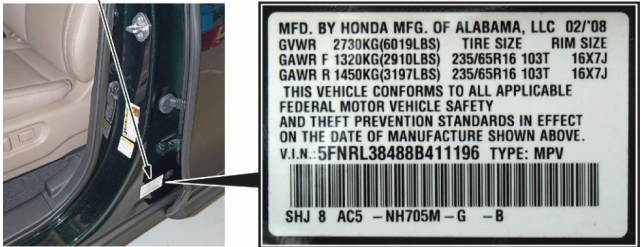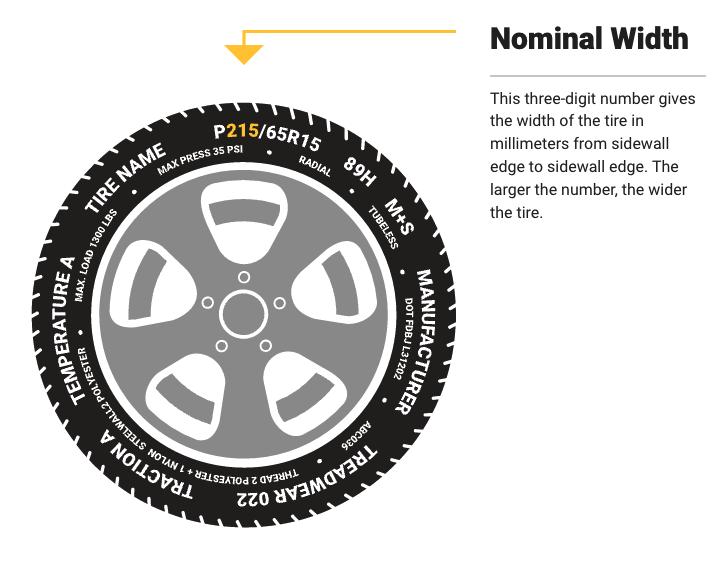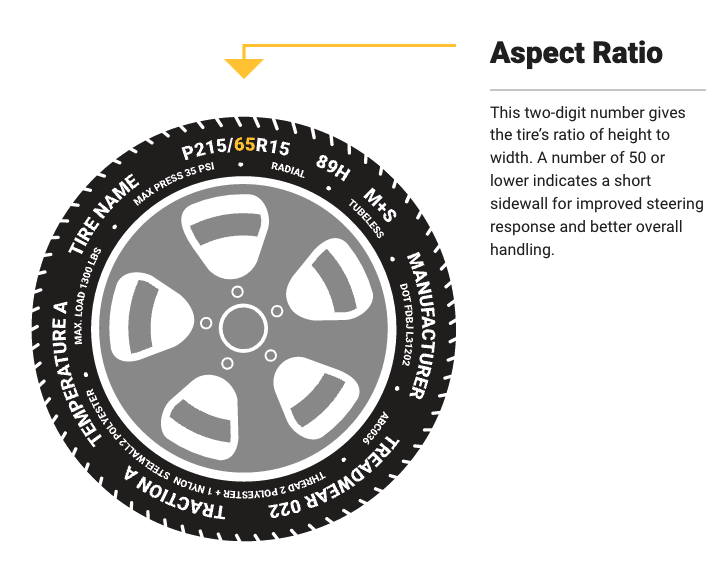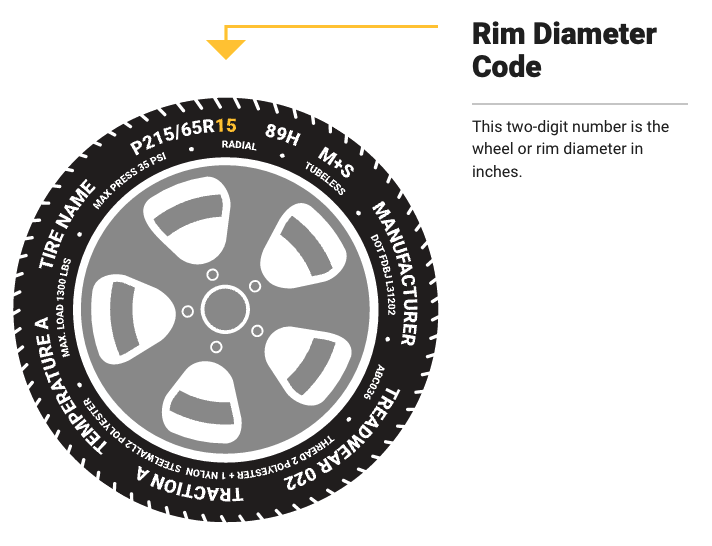Your Shopping Cart
Your cart is empty.
Subtotal ( items)
Instant Rebate Applied:
Promo Code Applied: ID.me Discount Applied:
Have a Promo Code?
Size:
Item
Item
Selected for:
/ each
Add-Ons
Wireless air pump capable of pumping up to 150 psi with 2000 MAH power bank.



Fully protect your clothes and vehicle interior during transportation of your tires. For Tires up to 31" tall and wheels up to 22".
Per sensor
Add TPMS Sensors
/per sensor
Please confirm the make, year, model and trim of the vehicle you want to purchase for:
How many sensors do you need?
The vehicle you have selected is not compatible with aftermarket TPMS Sensors.
Enter a different vehicle to add TPMS sensors

 Front Tire Size:
Front Tire Size:
 Rear Tire Size:
Rear Tire Size:
 Your Vehicle:
Your Vehicle:
Pros & Cons of Staggered Fitment

Attractive Design

Improved Handling

Improved Cornering
Bumpier Ride
Poor Traction in Snow
How do I find my tire size?



Need help?
 Your Vehicle:
Your Vehicle:
Pros & Cons of Staggered Fitment

Attractive Design

Improved Handling

Improved Cornering
Bumpier Ride
Poor Traction in Snow
How do I find my tire size?



Need help?
Pros & Cons of Staggered Fitment

Attractive Design

Improved Handling

Improved Cornering
Bumpier Ride
Poor Traction in Snow
Need help?
Need help?
How do I know if I have an LT tire?

 Your Vehicle:
Your Vehicle:
Sorry, we could not find any available
wheels for your sizing selections.
Need help?
Guide to Tire Sizes: How to Read Tire Size
By Tire Agent Staff
March 27, 2024
This post answers common questions about how to read wheel size and where to find tire sizes.
Why are there so many tire sizes? The variety in vehicle tire sizes stems from the wide range of vehicle types, purposes, and performance requirements. Here are several key reasons why vehicles use different tire sizes and there's no one-size-fits-all tire.
- Vehicle type and size: Larger vehicles, SUVs and light trucks, require larger tires to support their heavier weight and larger size. Smaller cars can use smaller tires because they have less weight to support.
- Performance requirements: High-performance vehicles may need wider tires to provide more grip and stability at higher speeds, while economy cars might prioritize smaller, narrower tires for better fuel efficiency.
- Handling and ride comfort: The size of a tire can significantly affect a vehicle's handling and ride comfort. Larger tires with higher sidewalls can absorb road imperfections better, offering a smoother ride, whereas lower-profile tires might provide a firmer ride but better handling and responsiveness.
- Load carrying capacity: Vehicles designed to carry heavy loads or tow trailers require tires that can safely support the weights they haul. This often means larger and stronger tires with higher load ratings.
- Aesthetic preferences: Some tire sizes are chosen for aesthetic reasons, with larger rims and lower-profile tires offering a more aggressive, sporty look that many consumers desire.
- Fuel efficiency and environmental considerations: Tire size and design can impact a vehicle's fuel efficiency. Automakers may choose tire sizes that help reduce rolling resistance, thereby improving fuel economy and reducing environmental impact.
- Geographical and seasonal factors: Vehicles in regions with heavy snowfall and rough terrain may need larger, more robust tires, or even specialized tires for different seasons, to ensure safety and reliability under those specific conditions.
This diversity among tire sizes allows for a more tailored driving experience, ensuring that vehicles can meet the needs of their drivers, whether it's for day-to-day commuting, performance driving, off-road adventures, or heavy-duty hauling. The tire industry has evolved to offer a wide range of sizes and types of tires to match these varied requirements closely.
Are bigger tires better?
It depends on what “better” means to you. Bigger tires increase traction, cornering and handling, but they sacrifice other aspects of driving, and possibly fuel efficiency.
Now that you know the correct tire size for your vehicle, we suggest sticking with the recommendations. If you try to use a different tire size, it could lead to performance and safety issues.
If you have your heart set on changing sizes, maybe because you're looking to add custom rims, your best bet is to speak with a tire professional to find a size range that works for your vehicle.
Don't understand all the numbers on your tires? Keep reading for a quick breakdown of what the numbers indicate.
How to Find the Right Tire Size for Your Vehicle 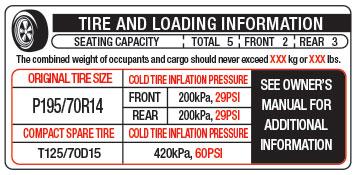
There are a couple of easy methods to find the manufacturer's recommended tire size for your vehicle.
Check your owner's manual. You know that handy guide that comes with all cars that's probably collecting dust inside your glove box? If you can't find the manual, try the second method. Many manufacturers publish their owners' manuals online. Look there if it's gone from the glove box. (Actual tire placard by Honda from NHTSA.)
Check the door jamb. The second method for finding your manufacturer's tire size recommendation is by looking at the place card inside your vehicle. You'll find this attached inside the driver's side door jamb, in most cases. (Sample tire placard from Bridgestone/Firestone.)
How to Read Tire Sizes and Wheel Size
3 ways tires are measured
Have you ever looked at the writing on your tires? There are tons of information on them that you might not understand. In this post, we focus solely on tire size. We have a related post that explains more about cracking tire codes.
There are three key pieces of information that you need to know when measuring tires. Once you understand these numbers, you can look at the tires on your car to see the size you're currently using and make sure they meet recommendations.
One of the most common tire sizes is P 215/65 R 15. The P stands for passenger vehicle tire. You might see LT or ST instead of the P. Those stand for light truck tire and special tire.
But we're going to focus on the numbers and what they mean. Let's take a look at tire dimensions now.
Source: NHTSA
1. Tire width
In the P 205/65 R 15 example, the 205 means the tire is 205 millimeters wide, looking at the tire head-on.
2. Aspect ratio
The second number, 65, represents the tire's aspect ratio. Aspect ratio indicates the tire's height is 65% of the tire's width. The bigger the aspect ratio, the larger the sidewall of the tire.
You can check out our extensive report on tire aspect ratio here.
3. Wheel or rim diameter
The final number of importance is 15. The 15 signifies the rim diameter of the wheel that the tire will fit. So, the rim size that you'd need is 15-inches.
Do these numbers on your vehicle's tires match the manufacturer's recommendations? If not, speak with a tire professional to ensure you're driving safely. To shop for tires by size from Tire Agent, from any page, select the “SHOP BY SIZE” option, then enter your width, aspect and diameter.
More resources to find the perfect tire
Tire size is just one factor when looking for the perfect match. There are other things to consider. Don't worry. We've got you covered.
Guide to tire temperature ratings
In this guide, we explain one set of characters on your sidewalls: tire temperature grades.
Understanding tire treadwear ratings
Treadwear ratings are supposed to help us determine the value of a tire and answer questions like, how long will a tire last? And, is the tire’s expected life worth its price? Find tire tread wear info that you're looking for.
The meaning of tire traction rating
Tire traction scores refer to a tire’s ability to stop on wet pavement. The higher the rating, the shorter the stopping distance. Check out our complete breakdown here.
Photo 71641465 | Tire | Alex Semenov | Dreamstime.com
Next Post:
Best Replacement Tires for Honda CRVHow to Qualify for the $50 Offer
- Add items to your cart and begin checkout.
- Select PayPair and apply for financing.
- If you’re approved by a participating lender, you’ll see a $50 promotional rebate applied to your order total.
-
To receive the $50, you must:
- Complete your purchase with a qualifying lender,
- Agree to the payment terms,
- And make the required number of consecutive on-time payments, as specified by the lender.
Note: Offer available only through select lenders. Additional eligibility requirements and conditions apply. Rebate may be issued after verification of qualifying payment activity. Terms subject to change.
How to Purchase Tires and Wheels
With a Payment Plan
Tire Agent's payment plans make it easy to get the best partial or full set of tires and wheels for your vehicle.
It's fast, secure and won't affect your credit score
Match with multiple lenders
Why Choose PayPair?
PayPair’s Partners and Plans

No Money Down

No Money Down

No Credit Needed*

No Money Down

$1 to Start!*

No Money Down

No Credit Needed*

$1 to Start!*

No Money Down
Other Payment Plans

$0 to Little Down

Pay with your bank account

Simplified checkout experience

Faster and easier than using cards or cash

Simplified checkout experience

Faster and easier than using cards or cash
*SNAP: The advertised service is a lease-to-own agreement provided by Snap RTO LLC. Lease-to-own financing is not available to residents of Minnesota, New Jersey and Wisconsin. NO CREDIT NEEDED: Not all applicants are approved. While no credit history is required, Snap obtains information from consumer reporting agencies in connection with applications, and your score with those agencies may be affected. PAYMENT PLAN: The standard plan consists of renewable lease terms. To exercise an early ownership, consumers must make regular payments on time and schedule additional payments via the customer portal or by contacting Customer Care at 1-877-557-3769. KATAPULT: The Promotional Initial Payment (plus any applicable taxes and fees) is due at lease signing. Your lease-purchase payment amount will be determined after you select your product(s). You will not acquire ownership of the product(s) if the total amount necessary to acquire ownership is not paid. The Promotional Initial Payment does not reduce the cost of the lease-purchase agreement. The Promotional Initial Payment is only available when shopping at Tire Agent through the Katapult mobile app and at Tire Agent’s website. Product pricing subject to change and availability. Disclosure: 90-day early purchase option (EPO) terms and conditions apply: 90-Day (3 months in CA) You can buy out your lease-to-own agreement within the first 90-days. This amount includes the cash price, plus the lease-to-own cost for the first 90-days. Taking advantage of the 90-day purchase option will save you the most money! PROGRESSIVE: Ownership by rental/lease agreement with Progressive Leasing costs more than the retailer’s cash price. Select items only. Cancel or purchase early at any time. Not available in MN, NJ, VT, WI, WY. Progressive Leasing obtains information from credit bureaus. Not all applicants are approved. Standard agreement offers 12 months to ownership. 90-day purchase options cost more than the retailer’s cash price (except 3-month option in CA). To purchase early or to cancel lease, you must call 877-898-1970. Retailer cannot activate early purchase options.


